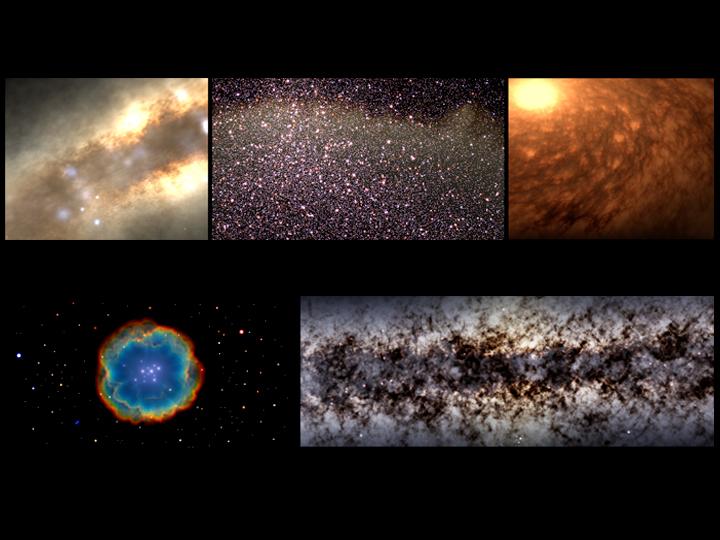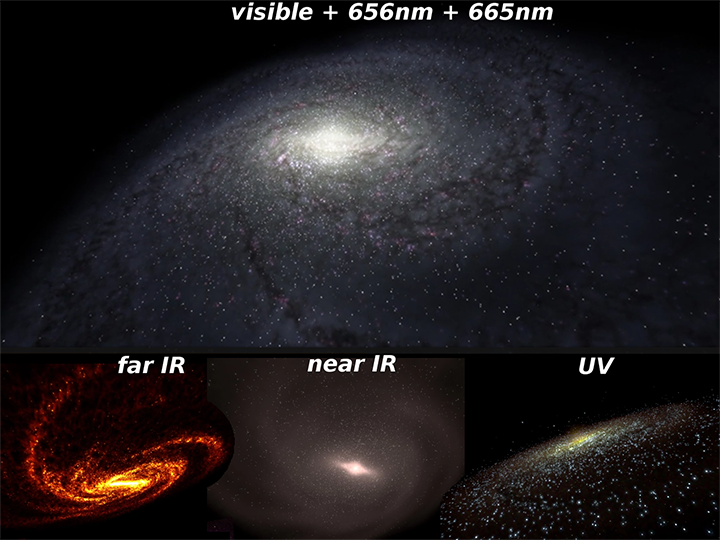Fabrice Neyret, a CNRS’s researcher of the team Maverick at the Inria Grenoble - Rhône-Alpes centre, is specialised in computer graphics. His special talent is making reproductions of the natural world in all its immensity and in full detail and, whenever possible, in real time. So it was hardly surprising that RSA Cosmos, which produces digital interactive planetariums, should have turned to him for the ambitious veRTIGE project. The company wished to add a Hubble-quality virtual galaxy to its product, in which spectators could move anywhere in real time. They would then be immersed in a magnificent world of star clusters melting into a luminous fluid, interspersed with swathes of dark clouds formed by the great spirals, speckled with nebulae glowing in the light of newborn blue giants, bombarding their dusty cocoon with UV.
A risky mission
As RSA Cosmos Chief Executive, Benjamin Cabut, points out, this project, accredited by the French National Research Agency (ANR) in 2010, has run up an impressive list of world-firsts. For the first time, it is possible to visualise the real results of astrophysical simulation of galaxies integrating stellar and galactic models. It is also the very first interactive visualisation built from real semi-transparent volumes, rather than a simple series of points.
“Everything in this project was difficult,” explains Fabrice Neyret. “We were dealing with an ‘astronomical’ amount of data, and a huge range of diverse physical phenomena. In addition, we had to bring very different things together: a very blurry physical simulation of the contents of the galaxy, (partial) star catalogues, and amplification algorithms to create missing details while complying with statistical observations and the reference Hubble images.” What made the mission even riskier was that all the calculations had to be completed within 1/60th of a second, in semi-transparent volumes, and in all wavelengths of light, “in other words, 10 million times faster than is necessary for special effects in the film industry, even though these are based on the work of artists and not on real data and equations.”
An essential cross-disciplinarity
This virtual galaxy is the result of intense collaboration between RSA Cosmos, Maverick and the Paris-Meudon Observatory, which supplied the data as well as astronomical and astrophysical models. “Astronomers and astrophysicists focuses on the abstract precision of their advanced models, but not on explaining each detail of shape and colour. And yet, that is what interests the spectators watching the telescope images… and it’s also what we are interested in when we are working in image synthesis. To understand and reproduce what we see in the Hubble images, we were left with a huge amount of work to accomplish, not only to put together the (incomplete) scientific puzzle, but also to rework the models and equations. Even in terms of algorithms, there is a cultural gulf. While their ‘Galmer’ simulation provides us with a ‘bare model’ of the galaxy, it takes months of computation on a supercomputer to obtain very blurry results, and takes up way more memory than is available on a personal computer. This is a long way from the realistic, real-time 3D spirit of PC video games, which is what we needed in the end!”
This project was enormous, really at the limit of what a human mind can engulf, but it was fascinating from every point of view.
On Maverick side, Fabrice Neyret therefore had to rework models, data and algorithms to adapt them for the calculation of realistic real-time images by conventional computers with limited capabilities. One of the secrets at the heart of the Evasion and Maverick project teams’ work is to generate “on the fly” only what is strictly necessary for the image. “That is how we manage to represent the infinite complexity of the world in a limited amount of time, on a computer with limited capabilities.”
Eventually, after four years of work, the joint team succeeded in developing several high-quality models of various phenomena, based
RSA Cosmos : Mikaël Lermercier, Reynald Arnerin, Benjamin Cabut
Observatoire de Paris-Meudon : Yannick Boissel, Frédéric Arenou, Françoise Combes, Paola Di Matteo
Maverick team (Laboratoire Jean Kuntzmann, Inria) : Fabrice Neyret, Pascal Guehl
on Maverick’s GigaVoxels technology. This enabled RSA Cosmos to produce a first version integrated into its Sky Explorer software for use in planetariums. “This project was enormous, really at the limit of what a human mind can engulf, but it was fascinating from every point of view,” Fabrice Neyret concludes. “We have remained in contact. We would like to find ways to continue the adventure!”

